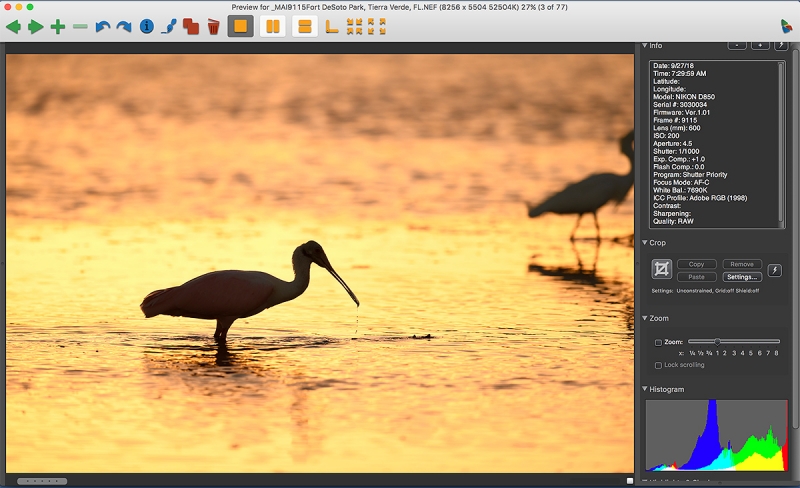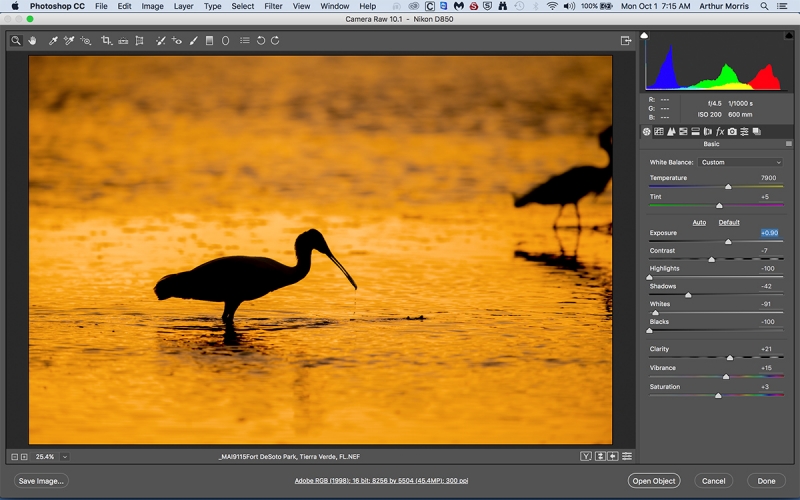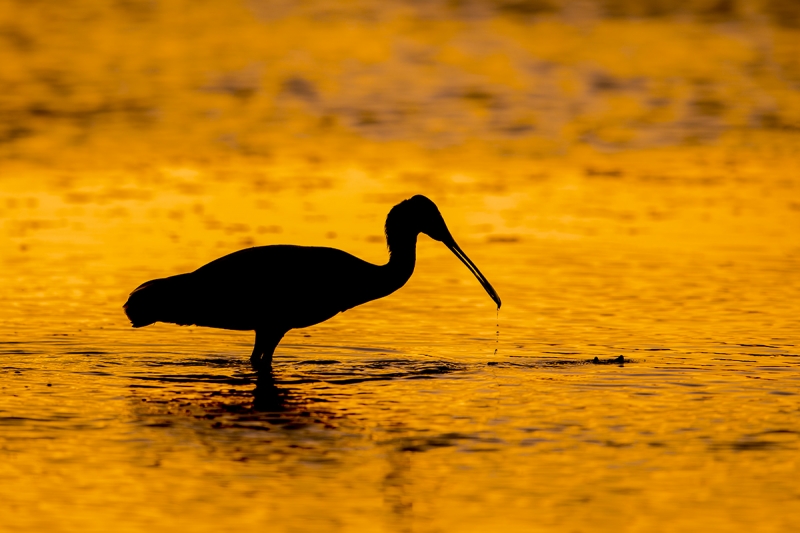Stuff
I watched lots of NFL football yesterday. I view the games using a combination of NFL Season Ticket and Tivo. I blew lots of balloons and did get around to testing a new ballhead system that turned out to be pretty neat. I will be sharing more on that here fairly soon.
Help Needed
In Saturday’s Shutter Priority for Pre-dawn Blurs blog post here, only a single (actual) person left a substantive comment and nobody, no one, zero, zilch responded to either of the questions below, questions that designed to help you learn to become a better photographer. If you have a minute to revisit the post and leave a comment it would be appreciated.
Shutter Speed Question
What is the general principle that explains why I went with 1/60 sec. for the image of the single tern but with 1/30 sec. for the flock blur?
Degree of Blurring Question
Considering that the shutter speed is the same :), why are the birds in the top half of the frame more blurred than the birds in the bottom half of the frame?
News on the Galapagos Front/Limit 12/Openings: 3
Right now I have nine folks committed to the 2019 Galapagos Photo Cruise. A friend who had committed to the trip learned that he and his wife might not be able to attend. Thus, I have room for a couple or for two same-sex roommates, and for a male single. If the archipelago is on your bucket list, please get in touch via e-mail asap with questions. If you might be registering with a friend or a spouse do ask about the two at a time discount. See the complete details here.
BIRDS AS ART
BIRDS AS ART is registered in the U.S. Patent and Trademark Office.


Selling Your Used Photo Gear Through BIRDS AS ART
Selling your used (or like-new) photo gear through the BAA Blog is a great idea. We charge only a 5% commission. One of the more popular used gear for sale sites charged a minimum of 20%. Plus assorted fees! Yikes. They went out of business. And e-Bay fees are now up to 13%. The minimum item price here is $500 (or less for a $25 fee). If you are interested please scroll down here or shoot us an e-mail with the words Items for Sale Info Request cut and pasted into the Subject line :). Stuff that is priced fairly — I offer pricing advice to those who agree to the terms — usually sells in no time flat. Over the past year, we have sold many many dozens of items. Do know that prices on some items like the EOS-1D Mark IV, the 5Ds and 5Ds R, the old Canon 500mm, the EOS-7D, the Canon 200-400 with internal extender, and the original 400mm DO lens have been dropping steadily. Most recently the price of used Canon 600mm f/L IS II lenses have been dropping like a rock with the introduction of the 600 III. You can always see the current listings by clicking here or on the Used Photo Gear tab on the orange-yellow menu bar near the top of each blog post page.
September Sales
Ron Gates sold a Canon EOS 7D in near-mint condition for $350 in mid-September.
Will Craig sold a Canon EF 300mm f/4L IS USM lens in excellent condition for $674.00and a Canon EF Extender 1.4X III in near-mint condition for $329.00 about one week after they were listed in mid-September.
Will Craig sold an original Canon EOS 7D camera body in excellent condition (with fewer than 26,000 actuations) for $299.00 soon after it was listed in September, 2018.
Anthony Ardito sold a Canon EOS 5D Mark IV body in like-new condition (with extras) for $2,499.00 in early September, 2018.
Anthony Ardito also sold a Canon EF 600mm f/4L IS II USM lens in like-new condition (with extras including a 2X III TC) for $8,500.00 in early September, 2018.
I sold my Canon 1.4X III teleconverter for $329.00 in early September before listing it.
Amy Novotny’s Nikon TC-E-20 (teleconverter) sold the first day it was listed in early September for $249.00.
Richard Gollar sold his Canon EF 500mm f/4 L IS (the original IS model, the “old five”) in near-mint condition for $3399.00 in early September.
Airbnb
For the past few months, I have been hearing folks use the word Airbnb, most notably, Amy Novotny. Out of curiosity I asked a few questions. What I learned amazed me. Join Airbnb and become part of a community that connects global travelers with local hosts across the world. Find a place to stay and discover things to do. Airbnb lists more than 4.5 million homes across 200 countries; you’ll find spacious, affordable options for every occasion. With Airbnb you will travel with confidence as reviews from past guests help you find the right fit. Once you do, our secure messaging makes it easy to coordinate with your host. And Airbnb support teams are available 24/7. Last night I made a reservation for an Airbnb apartment for my upcoming January San Diego visit: 13 nights with a full kitchen and two bedrooms.
Yikes. I almost forgot the best part: Airbnb rates average less than half of even the least expensive chain hotels and motels. If you would like to save $40 on your first booking sign up by using this link: Airbnb. Airbnb does charge clean-up and service fees that make short stays less attractive bargains than long stays.
Those who prefer to stay in a motel or hotel are invited to use the Booking.com link below to save $25.00.
Booking.Com
Several folks on the UK IPT used the Booking.Com link below for their Edinburgh hotels, got great rates, and saved a handsome $25.00 in the process. If you too would like to give Booking.Com a shot, click here and to earn a $25 reward on your first booking. Thanks to the many who have already tried and used this great service.
Money Saving Reminder
If you need a hot photo item that is out of stock at B&H, would enjoy free overnight shipping, and would like a $50 discount on your first purchase, click here to order and enter the coupon code BIRDSASART at checkout. If you are looking to strike a deal on Canon or Nikon gear (including the big telephotos) or on a multiple item order, contact Steve Elkins via e-mail or on his cell at (479) 381-2592 (Eastern time) and be sure to mention your BIRDSASART coupon code and use it for your online order. Steve currently has several D850s in stock — your purchase includes a free 64gb XQD card and the XQD reader!). He also has two Nikon 180-400s in stock. And he is taking pre-orders for the new Nikon 500 P and the Nikon Z6 mirrorless camera body as well as for the Canon 600 III. He already has two BAA blog orders for the new Canon six.
|
|
|
This image was created at Fort DeSoto Park on the early morning of Sunday, September 27, 2018, the last day of the I-went-with-one IPT. I used the Induro GIT 304L/Mongoose M3.6-mounted Nikon AF-S NIKKOR 600mm f/4G ED VR AF lens and my souped-up (9 fps) Nikon D850. AUTO ISO 200. Matrix metering +1 stop: 1/1000 sec. at f/4.5 in Shutter Priority mode (S in Nikon, Tv with Canon). WB: 7690 K at 7:30am with a very few clouds on the eastern horizon. One down and to the left of center Group (grp) Continuous (AI Servo in Canon) shutter button AF was active at the moment of exposure as originally framed (above). The array was centered on the front end of the spoonbill. Phase detection AF Fine-tune value: a significant +5. See the Nikon AF Fine-tune e-Guide here. Photo Mechanic screen capture for today’s featured image.
|
Toasting the RED Channel
As invariably happens when creating sunrise and sunset images, the RED channel in the original capture is showing as hot. Note the red peak completely butted against the rightmost (highlight) axis of the histogram. In almost all cases (as below), it is possible to recover the REDs during the RAW conversion. If you underexpose enough in these situations to move the RED channel away from the rightmost axis, the colors will be muddy and underexposed at best. At worst, you will have a black bird against a black background …
|
|
This screen capture shows the position of the ACR sliders for today’s featured image.
|
The ACR Conversion: There’s a First Time for Everything …
The screen capture above shows the position of the ACR sliders on the Basic tab for today’s featured image: Exposure/+9; Contrast/-7; Highlights/-100; Shadows/-42; Whites/-91; and Blacks/-100. Consider that I rarely touch the Contrast slider, that I have never set the Highlights and Blacks sliders to -100, or the Shadows slider anywhere near -42. Note that I did reduce the Luminance of the ORANGES and the YELLOWS significantly on the HSL tab.
So why did I come up with this unique combination of slider values? To make the image look the way I wanted it to, pretty close to the way it appeared in life.
|
|
|
This image was created at Fort DeSoto Park on the early morning of Sunday, September 27, 2018, the last day of the I-went-with-one IPT. I used the Induro GIT 304L/Mongoose M3.6-mounted Nikon AF-S NIKKOR 600mm f/4G ED VR AF lens and my souped-up (9 fps) Nikon D850. AUTO ISO 200. Matrix metering +1 stop: 1/1000 sec. at f/4.5 in Shutter Priority mode (S in Nikon, Tv with Canon). WB: 7690 K at 7:30am with a very few clouds on the eastern horizon. One down and to the left of center Group (grp) Continuous (AI Servo in Canon) shutter button AF was active at the moment of exposure as originally framed (above). The array was centered on the front end of the spoonbill. Phase detection AF Fine-tune value: a significant +5. See the Nikon AF Fine-tune e-Guide here. Roseate Spoonbill, sunrise silhouette/the optimized version
|
The Optimized Version
I was (and am) quite happy with the optimized version. Note that D850 images can easily handle large crops. The two black things in front of the bird are the fins of a fish, likely one that just escaped capture.
|
|
The BIRDS AS ART Current Workflow e-Guide (Digital Basics II).You can order your copy from the BAA Online Store here, by sending a Paypal for $40 here, or by calling Jim or Jennifer weekdays at 863-692-0906 with your credit card in hand. |
The BIRDS AS ART Current Workflow e-Guide (Digital Basics II)
Learning to balance the color in your images using a variety of methods, learning to tame hot REDs, learning to use the White Balance eyedropper, and tons more is covered in detail in the BIRDS AS ART Current Workflow e-Guide (Digital Basics II), an instructional PDF that is sent via e-mail. Learn more and check out the free excerpt in the blog post here. While the new e-Guide reflects my Macbook Pro/Photo Mechanic/DPP 4/Photoshop workflow, folks using a PC and/or BreezeBrowser will also benefit greatly by studying the material on DB II. Do note that you will find the RGB Curves Adjustment Color Balancing tutorial only in the new e-guide. Note: folks working on a PC and/or those who do not want to miss anything Photoshop may wish to purchase the original Digital Basics along with DB II while saving $15 by clicking here to buy the DB Bundle.
The two most recent and many of the older MP4 Photoshop Tutorial videos releases go hand and hand with the information in DB II):
Folks who learn well by following along rather than by reading can check out the complete collection of MP 4 Photoshop Tutorial Videos by clicking here.
Though I have become more proficient converting my Nikon RAW (NEF) files in Adobe Camera Raw, I continue to optimize my Canon image in DPP 4. You can learn how and why I converted (and still convert) nearly all of my Canon digital RAW files in DPP 4 in the DPP 4 RAW Conversion Guide here. And, yes, I still have many Canon images to work on. 🙂 The RAW conversions for all three of today’s featured images was straightforward once I entered my camera/ISO specific recipes (as detailed in the DPP 4 RAW Conversion Guide). You can learn advanced Quick Masking and advanced Layer Masking techniques in APTATS I & II. You can save $15 by purchasing the pair. Folks can learn sophisticated sharpening and (NeatImage) Noise Reduction techniques in the The Professional Post Processing Guide by Arash Hazeghi and yours truly.
Help Support the Blog
Please help support my efforts here on the blog by remembering to click on the logo link above each time that you shop Amazon. That would be greatly appreciated. There is no problem using your Prime account; just click on the link and log into your Prime account. With love, artie
If In Doubt …
If in doubt about using the BAA B&H affiliate link correctly, you can always start your search by clicking here. Please note that the tracking is invisible. Web orders only. Please, however, remember to shoot me your receipt via e-mail.




Please Remember to use my Affiliate Links and to Visit the New BAA Online Store 🙂
To show your appreciation for my continuing efforts here, we ask, as always, that you get in the habit of using my B&H affiliate links on the right side of the blog for all of your photo and electronics purchases. Please check the availability of all photographic accessories in the New BIRDS AS ART Online Store, especially the Mongoose M3.6 tripod head, Wimberley lens plates, Delkin flash cards and accessories, and LensCoat stuff.
As always, we sell only what I have used, have tested, and can depend on. We will not sell you junk. We know what you need to make creating great images easy and fun. And please remember that I am always glad to answer your gear questions via e-mail.
I would of course appreciate your using our B&H affiliate links for all of your major gear, video, and electronic purchases. For the photographic stuff mentioned in the paragraph above, and for everything else in the new store, we, meaning BAA, would of course greatly appreciate your business. Here is a huge thank you to the many who have been using our links on a regular basis and those who will be visiting the New BIRDS AS ART Online Store as well.
Be sure to like and follow BAA on Facebook by clicking on the logo link upper right. Tanks a stack.
Typos
In all blog posts and Bulletins, feel free to e-mail or to leave a comment regarding any typos or errors. Just be right :).


















Nothing like a little gilt to wake us up 😉
Shutter Speed Question
What is the general principle that explains why I went with 1/60 sec. for the image of the single tern but with 1/30 sec. for the flock blur?
– The greater the focal length, the more blur. General rule of 1/equivalent focal length
Degree of Blurring Question
Considering that the shutter speed is the same :), why are the birds in the top half of the frame more blurred than the birds in the bottom half of the frame?
– Birds at the top half are further away from the camera.
Yes to the guilt, thanks 🙂 The first answer is incorrect, in part because the focal length in the two images was the same, 500mm …
For the second, you got the answer reversed — the closer the birds the more the degree of blurring at a given shutter speed …
But thanks for easing your conscious 🙂
with love, artie
Shutter Speed Question
What is the general principle that explains why I went with 1/60 sec. for the image of the single tern but with 1/30 sec. for the flock blur?
The general principal is that the single bird is closer to the camera, so the “relative” movement across the frame of the image over a given time is greater. (i.e. the wing tip will travel across more pixels in a given time than a bird much farther away.) So, in order to get a similar blur, you will need more time with the birds farther away.
Degree of Blurring Question
Considering that the shutter speed is the same :), why are the birds in the top half of the frame more blurred than the birds in the bottom half of the frame?
The birds in the top half of the image are closer to the camera than the birds lower in the image. This image shows the general principal described above very well. (And I am sure that was not an accident, Oh Great Teacher…)
1/60 Wanted sharper face focus?
Yes, in part. The difficult-to-attain goal is to get the eye sharp …
with love, artie